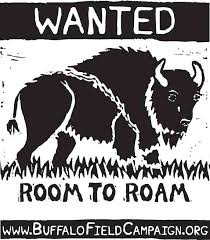Buffalo Chips in the Policy Game
By: John A. Baden, Ph.D.Posted on January 21, 2016 FREE Insights
During the post-Civil War period, from 1865 to 1910, America resembled a rapidly developing Third World nation. Life expectancy was just over 40 years and average income was less than one twentieth of today’s. Corrupt big city machines and corporate cronyism marked our political economy.
Plunder, pollution, and predation were common. Property rights to natural resources were neither well defined nor enforced. Timber seemed inexhaustible and fish and wildlife were available for exploitation. Antelope, bison, and elk were nearly extinguished while predators including bear, bobcat, lion, and wolves carried bounties.
A conservation ethic for our natural resources was rare but developed as an important force among America's elite. The creation of the Boone and Crockett Club and forestry schools at Cornell, Harvard, and Yale testify to major cultural changes. These are important features of Progressive Era reforms.
For example, Boone and Crocket helped expand Yellowstone National Park and led the American Conservation movement. It helped eliminate commercial market hunting and led the creation of the National Park Service, the U. S. Forest Service, and the National Wildlife Refuge system. It also developed funding mechanisms for conservation.
Since we can't (yet) reintroduce the saber tooth tiger, extinct for some 12,000 years, I can't think of a solution analogous to the wolf-elk population fix for the 5,000 bison overgrazing the Park’s Lamar Valley. Management options are constrained by political forces, fantasy ecological creations of naïve young people, and the ignorance of well-intended citizens.
The problem of an ever-expanding herd of Yellowstone bison demonstrates important principles of environmental policy. Ecological issues usually have two characteristics that make management difficult. They are scientifically complex while carrying heavy emotional baggage. This conjunction is a recipe for error and acrimony as policies are formulated and implemented. Yet, things that can’t go on indefinitely will somehow stop. What is the best way arrest bison population growth given ecological, political, and economic constraints?
One important consequence of bison numbers stressing their habitat, especially in winter, is their leaving the park for lower elevations. Bison evolved to migrate. Here is a statement on this problem of bison management from the Park Service: “But in the winter, when they migrate to lower elevations outside the park in search of food .... some are infected with the disease brucellosis that can be transmitted to cattle.”*
Here's my exploratory idea for reform. Park Service and outside scientists estimate the Park’s carrying capacity for bison. This number might range from a few old bulls to a small but sustainable breeding herd. Then initiate a long public education program on the multiple and ever growing problems of excessive bison numbers. It would include a time series of photographs showing the degradation of the range, a pathological condition naturally caused by excessive numbers of animals trying desperately to survive. Then, to provide new habitat, enter a cooperative agreement with, for example, the American Prairie Reserve. APR could take the Park's excess and manage the resultant herd within their 3.5 million acres.
As a non-governmental land trust, APR range and wildlife scientists are far better insulated from political pressures than those in a governmental agency. The APR would market the bison along with their cattle via their Wild Sky Beef program. Wild Sky Beef "supports wildlife-friendly ranching by returning a portion of its profits to participating ranchers raising cattle to a set of specific conservation-oriented practices. By creating incentives for ranchers to view wildlife as an asset we plan to blur the boundaries of the Reserve with surrounding agricultural lands."

Being a non-profit 501 (c-3) trust with open books, they have freedom to innovate Park leaders that their colleagues can only envy.
Here is the American Prairie Reserve’s position told to me by Sean Gerrity, the founder and president of the American Prairie Reserve:
“We are of course very interested in taking Yellowstone bison (provided they are tested with SNPS technology and certified disease free, which is not hard to do) and incorporating them on the APR. Happy to take them anytime and let the public enjoy them as they are doing with the bison roaming the prairie out there now.”
An obvious question is, where else could this happen? What other areas could provide habitat and good management for the Yellowstone bison?
In contrast with the American Prairie Reserve approach, the Buffalo Field Campaign is a persistent group of Green activists strongly opposed to current bison management in and around Yellowstone. It proposes a radically different alternative:

“We envision a life for buffalo in which they thrive within the state of inherent wildness as expressed in the Buffalo Bill of Rights. We also envision a world in which buffalo and all other native wildlife are given precedence on public land, and that buffalo herds will remain as a self-regulating sustainable population, and a viable genetic source for the future evolution potential of the species.”
However well intended, this position ignores the reality of population dynamics. Bison excel at making more bison, they are genetically programed to do so, and they have no effective predators. If Yellowstone Park is to honor the Park Service mission, then it must somehow control bison numbers. Park policy will evolve to do this.
Yellowstone National Park is a conservation experiment, one that evolved from management by the U.S. Army. This experiment is ongoing and subject to ecological, political, and economic reality checks. The bison population problem is one to watch. We can learn from earlier, highly contentious issues of feeding bears, exterminating wolves, and extinguishing fires. Finding a solution will require wise and courageous Park Service managers. A successful outcome will surely involve the kind of environmental entrepreneurship being demonstrated on the American Prairie Reserve.
In sum, there are two major problems of bison management in Yellowstone. The one internal to the Park is habitat degradation due to prolonged overgrazing. The second includes a range of costs, externalities in economic terms, of bison leaving the Park. The later are politically far more important while the former is a greater challenge to the mission of the Park Service, to protect and preserve the ecology.
*Here is a complementary statement from the University of Colorado:
BRUCELLOSIS AND YELLOWSTONE BISON IN MONTANA
CONFLICT RESEARCH CONSORTIUM
Working Paper #95-2
By Emily Davies, Department of Sociology, University of Colorado, Boulder
Brucellosis, or Bang's disease, is commonly found in buffalo, elk and domestic cattle. Cattle, specifically cows, are most susceptible to the disease and its effects however, and are prone to abortions, low milk production and even infertility when infected. Spread through contact with reproductive fluids or grass that is wet with such fluids, brucellosis is difficult to detect and even more difficult to prevent through inoculation. This holds particularly true for the wild, free-roaming Yellowstone bison...

